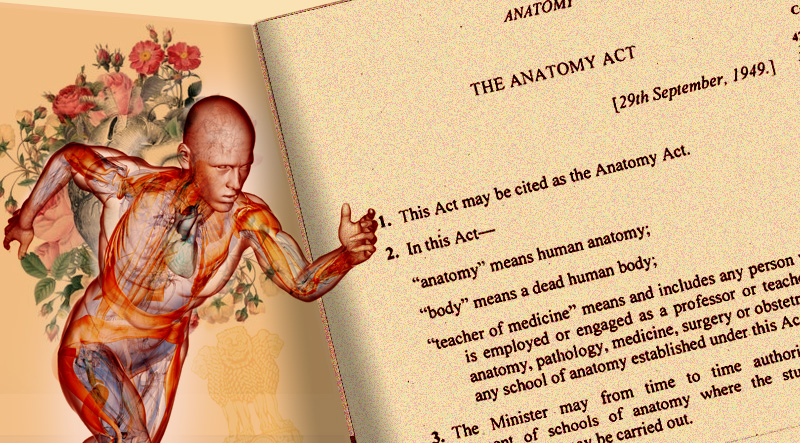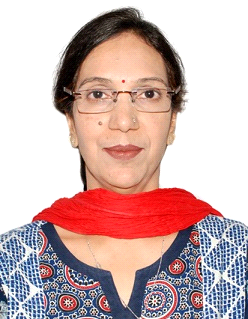A brief introduction to Anatomy Acts of India

 | Dr Vaishaly Bharambe, |
With the COVID pandemic Body Donation process was badly affected. There was discussion on legality of its various aspects and finally discussion about Anatomy Act itself. As an Anatomist dedicated to the cause of Human Body Donation, I would like to shed some light on this matter.
Anatomy Act: This is an Act that is made to govern human Body dissection for purpose of teaching as well as research.
History of Anatomy Acts: In the 18th and 19th Cenrury, all over the world Medical practitioners had started to dissect human bodies to understand its anatomy. There was a severe paucity of human cadavers. This led to Medical practitioners digging up fresh graves or dissecting criminals who had been hung untill death to understand the Anatomy. To legalize this scientific activity, Laws were made so that human cadavers could be legally made available to Medical Practitioners for their studies. Thus Anatomy Acts were formulated.
Thus Bombay Act came into being in 1949 in India. This was later modified and called as the Maharashtra Anatomy Act. This Act had jurisdiction over all areas that came under the State of Bombay. Soon other States came up with their own Anatomy Acts, such as “ The Tamilnadu Anatomy Act (1951), Delhi Anatomy Act (1953), U.P. Anatomy Act (1956)” and so on. Thus each State of India developed their own Anatomy Act and area of that State came under the purview of that Act. Some States ammended their Anatomy Acts as per the newer times and challenges, some did not or are in the process of doing so.
So what happens if we have so many Anatomy Acts in the same country? Are these acts different from each other?
The Anatomy Acts of each state have some similarities and some differences. Let us understand this further with a few examples.
Regarding Human Body Donation: Many Acts such as (Maharashtra, Karnataka and Kerala) allow unclaimed bodies as well as Donated bodies to be used for Anatomical dissection, whereas there are some Anatomy Acts (Haryana, Goa, Daman and Deu and Tamilnadu) which allow only the use of unclaimed bodies for Anatomical dissection. In such States, an affadavit may be required to be made to allow Human Body Donation. Some Medical Colleges may still continue Human Body Donation directly leading to differences in procedure of Human Body Donation within the same State as well as between different States of India. Some States such as Odisha have ammended their Anatomy Act to now allow for Human Body Donation.
Who will sign the Body Donation form by way of consent of family members? Here most Anatomy Acts insist upon the signature of the near relative. At this moment the Anatomy Act does not provide any solution to Body Donation of a person who has no consenting relatives to sign the consent form. Some Acts allow the signature of the religious sect to which the person had allegiance and some allow signature of a friend. Again in different States the Law speaks differently. Thus it is important for every peson working in the field of Body Donation to understand the Law of their State and promote/ facilitate Human Body Donation in keeping with the guidelines placed by that Law.
Purpose of the Act: While most States (Maharashtra, Haryana, Goa, Daman and Deu) formulated the Act so as to facilitate Anatomical “examination and research” and for “therapeutic purposes”. Anatomy Acts of some other States (Tamil Nadu, Uttar Pradesh) did not include therapeutic use of the donated cadaver. However, the therapeutic use of donated human body under the realms of Anatomy Act is not practiced as for therapeutic use of human body the HOTA Act i.e. the Human Organs Transplant Act is already functional.
The Anatomy Act clearly states that even if a person may have expressed their wish orally or in written form, to become Human Body donor after death they still have a right to withdraw their consent by expressing this wish orally to any relative or treating doctor. Nobody can be forced to be an Human Body donor.
The Anatomy Act states that the Donated body must be accepted only after submission of a Death certificate obtained from a RMP. The Law clearly states that any RMP who will be dealing with the body after the aforesaid Body donation has occurred cannot be the signing authority for the Death certificate.
Thus as you can see, India, a vast country with variable languages and multiple States has variable Anatomy Acts as well.
However the structure of Human Body is the same!!
Hence as an Anatomist, I believe that efforts need to be taken to bring the country together under a single Anatomy Act with few stipulations if necessary to accomodate any specific practices related to a particular region.The aim being that “No wish to donate body should ever go unfulfilled”.
This was a brief introduction to the Anatomy Acts of India. Further details can be obtained by reading individual Acts of each State.

